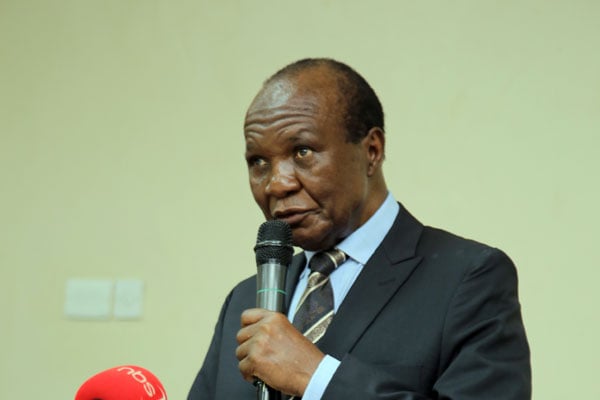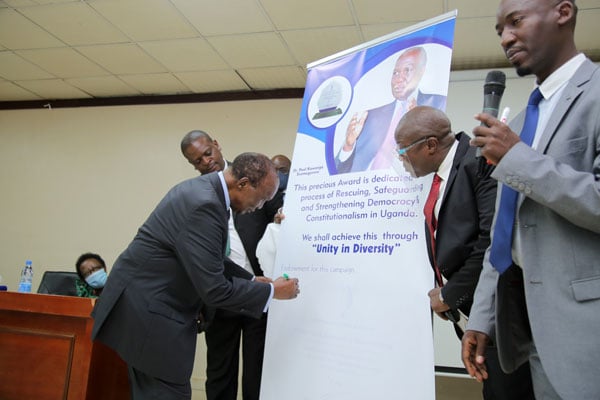Prime
Politician who became symbol of unity, grace

Paul Kawanga Ssemogerere speaks at a function in Kampala in October 2020. PHOTO/ ABUBAKER LUBOWA
What you need to know:
Paul Kawanga Ssemogerere’s lifetime of service in Uganda’s political space established him as one of the few actors still able to command mass appeal, writes Isaac Mufumba.
Paul Ssemogerere was thrust into the hot seat at the Democratic Party (DP) in trying times for both the party and Uganda.
After the overthrow of the Obote I government, president Idi Amin outlawed political party activities and also named DP leader Benedicto Kiwanuka Chief Justice. However, Kiwanuka—under whom Ssemogerere had earlier worked as Parliamentary Secretary—disappeared in 1972. It was against such a background that Ssemogerere took charge of a party that could not do politics.
The man whose political career had commenced in 1961-1962 when he was elected a member of the Legislative Council before being elected Member of Parliament for North Mengo, was forced to flee into exile in the United States of America.
Ssemogerere, who had earlier attended St Henry’s College Kitovu, Makerere University, Allegheny College in Meadville, Pennsylvania, before obtaining a Doctorate in Public Administration from Syracuse University, New York, participated in the Moshi Conference, which sat from March 24 to March 26, 1979, and formed the Uganda National Liberation Front (UNLF).
He later returned to Uganda to take up an appointment in Prof Yusuf Lule’s cabinet and also served as a member of Uganda’s Interim parliament, the National Consultative Council (NCC).
Into the deep
On June 20, 1979 the NCC voted Prof Lule out of office. He was forced to flee into exile, from where he had been expected to return and lead DP into the 1980 elections, but that plan was scuttled by Paulo Muwango’s Military Commission, which declared that it could not give any guarantees that Prof Lule would not be arrested on return to Uganda.
That thrust the 48-year-old Ssemogerere into the deep end.
1980 elections
Ssemogerere led the DP into the controversial 1980 elections. DP won the popular vote with 1,966,244 votes against UPC’s 1,963,679 votes, but could not form a government as it had not gotten majority seats in the House. DP had only managed 50 seats in Parliament against UPC’s 75 seats.
There were, however, questions about the credibility of the result. The election seemed to have been rigged long before Ugandans went to the ballot. The Military Commission had ignored proposals around the constitution of the Electoral Commission (EC); voter registration centres were manned by UPC supporters; potential DP candidates were in some cases denied the opportunity to be nominated as candidates; and constituencies were gerrymandered.
“In actual fact, it would appear, for no other purpose than gerrymandering, an arbitrary figure of a population quota of about 95,000 was adopted with an allowance of 25,000 either above or below this. This gave the Electoral Commission an allowance of 50,000 people to play with in demarcating the constituencies. It made it possible to carry out a high degree of gerrymandering… Consequently, illogical arrangement of constituencies became rampant so as to give UPC an advantage over other political parties,” Mr John Kabaireho, a former DP candidate in Bushenyi, wrote.
Opposition in Parliament
Given the unfair circumstances under which the polls were held, there were strong calls for the party to boycott Parliament. However, a meeting of the National Council of the party that was held at Rubaga Social Centre decided that the party takes up its seats in Parliament. Ssemogerere always believed it had been the right call.
“There were very strong voices for boycotting Parliament, and very strong voices for going to the bush. We thought we had a special role to promote reconciliation and national unity at that very difficult period in our history. We thought that was better for the country. When I look back now, it was the right decision,” Ssemogerere said in a 2014 interview with this newspaper.
Those were, however, very difficult times for Uganda. The Obote II government was being fought on several fronts by, among others, the Rwenzururu Movement, Uganda Freedom Movement (UFM), the Uganda National Rescue Front (UNRF), the Former Uganda National Army (FUNA), Federal Democratic Movement (FEDEMU) and the National Resistance Army (NRA).
The government’s response was to carry out mass and indiscriminate arrests (panda gari), detention without trial and extra-judicial killings.
Ssemogerere used his position as Leader of the Opposition and shadow minister for defence and security to try to make interventions that saved countless lives.
“I used the opportunity to interface with Muwanga, Oyite-Ojok and others … I don’t know how many lives I saved through these interactions … some people would have been dead if we hadn’t carried out these efforts,” he said, adding, “There are people I got from the Central Police Station when they were destined to be killed. Others I picked from Makindye, there was a go-down there which was very dangerous, and many other things…”
The “Black Book”
At some point in 1982, Ssemogerere announced that he had opened up a “Black Book” in which he was compiling and cataloguing the excesses of the Obote II regime.
The black book seemed to unsettle the regime into having a rethink in its approach to matters of security and human rights. Ssemogerere came under quite a lot of criticism for never making the contents of the book public. It was not until September 2014 that he responded to his critics.
“It (the Black Book) worked very much. It was a device which I found worth pursuing to expose wrongdoing. The Black Book was a deterrent; it was to warn you that whatever crime you committed was being documented and that it could all come back to haunt you in the future,” Ssemogerere revealed, adding, “It actually worked very well as a deterrent. I remember some of these members of the government of the time feverishly asking me, ‘now sir, what is my number in the Black Book, what did I do wrong?’”
Whereas it is difficult to ascertain the extent to which it helped save Ugandans from abuses, it is clear that the Black Book helped keep the regime in check.
Working for democracy
Ssemogerere, who had worked as a cabinet minister under presidents Tito Okello and Museveni, resigned from the latter’s government on June 13, 1995, citing “ideological grounds.”
The resignation was a couple of months before the July 1995 Constituent Assembly (CA) debate on political pluralism, which proponents of political pluralism later lost. That loss set the stage for Ssemogerere’s emergence as the candidate of the Inter Political Forces Cooperation (IPFC), which brought together DP, UPC and the National Liberal Party, in the 1996 General Election, an election that he lost largely because the NRM used his association with UPC and the much-loathed Milton Obote against him.
“A vote for Ssemogerere is a vote for Obote. Don’t forget the past. Over one million Ugandans, our brothers, sisters, family and friends, lost their lives. YOUR VOTE COULD BRING IT BACK,” read some of the campaign messages that the NRM put out.
Mr Peter Mukidi Walubiri, the leader of one of the factions of the opposition Uganda Peoples’ Congress (UPC), says item one on the IPFC post-election agenda was a return to multiparty politics.
“Item number one on the post-election agenda was the amendment of the Constitution to repeal Article 269 and demilitarise the politics by scrapping Army representation in Parliament. The other item was implementation of a minimum economic recovery programme,” Mr Walubiri said.




